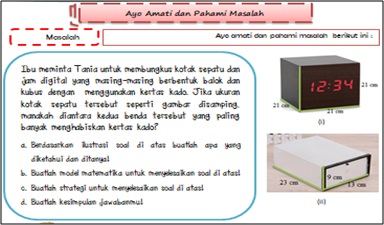
Development of Learning Device Based on 21st Century Skill with Implementation of Problem Based Learning to Increase Critical Thinking Skill of Students on Polyhedron for Grade 8th Junior High School
Abstract
Keywords
Full Text:
PDFReferences
Akbar, S. (2013). Instrumen Perangkat Pembelajaran. Bandung: Remaja Rosdakarya.
Arends, R. I. (2012). Learning to teach (9 ed.). New York, NY: McGraw-Hill.
Balitbang. (2013). Survey internasional PISA (Programme for International Student Assessment student). Jakarta: Kementerian Pendidikan dan Kebudayaan.
Depdiknas. (2008). Pengembangan Bahan Ajar. Jakarta: Direktorat Pembinaan Sekolah Menengah Atas Direktorat Jenderal Manejemen Pendidikan Dasar dan Manejemen Departemen Pendidikan Nasional.
Ennis, R.H. (2011). The Nature of Critical Thinking: An Outline of Critical Thinking Dispositions and Abilities. The University of Illinois.
Heleni, S., & Zulkarnain. (2018). The Influence of Mathematical Thinking Ability with Modified MOORE Method on Learning Outcomes of Basic Mathematic II Chemical Education Students. Journal of Educational Sciences, 2(2), 33-41.
Hidayah, R., Salimi, M., & Susiani, T.S. (2017). Critical Thinking Skill : Konsep dan Indikator Penilaian. Jurnal Taman Cendikia, 1(2), 2579-5147.
Hutapea, N. M. (2019). Improving Senior High School Students Learning Autonomy through Generative Learning. Journal of Educational Sciences, 3(1), 84-95.
Jonassen, D. (2011). Supporting Problem Solving in PBL. Interdisciplinary Journal of Problem-Based Learning, 5(2), 95-119.
Moore, E., & Stanley, T. (2010). Critical thinking and formative assessments: increase the rigor in your classroom. Lachmont: Eye in Education.
Normaya, K. (2015). Kemampuan Berpikir Kritis Siswa dalam Pembelajaran Matematika Dengan Menggunakan Model Jucama di Sekolah Menengah Pertama. Edumat Jurnal Pendidikan Matematika, 3(1), 92-104.
Pal, A., & Poyen, E. F. B. (2017). Problem Solving Approach. International Journal of Advanced Engineering Research and Science, 4(5), 184-189.
Plomp, T., & Nieveen, N. (2013). Education Design Research: an Introduction. Netherlands: Netherlands Institute For Curriculum Development.
Putri, A., Roza,Y., & Maimunah. (2019). Development of Learning Tools with the Discovery Learning Model to Improve the Critical Thinking Ability of Mathematics. Journal of Educational Sciences, 4(1), 83-92.
Rusman. (2008). Manajemen Kurikulum. Jakarta: PT. Raja Grafindo Persada.
Solfitri, T., Siregar, S. N., & Roza, Y. (2017). Pengembangan Perangkat Pembelajaran Matematika Berbasis Kurikulum 2013 Pada Materi Bangun Ruang Sisi Datar Dan Lingkaran Untuk Peserta didik Kelas VIII Tingkat SMP/MTS. Edu Math Journal Prodi Pendidikan Matematika, 4(1), 2337-7682.
Sugiyono. (2008). Metode Penelitian Kuantitatif, Kualitatif, dan R&D. Bandung: Penerbit Alfabeta.
Sulistyani, N. (2015). Pengembangan Perangkat Pembelajaran Bangun Ruang di SMP dengan Pendekatan Problem-based Learning. Jurnal Riset Pendidikan Matematika Universitas Negeri Yogyakarta, 2(2), 197-210.
Tanjung, H. S., & Nababan, S. A. (2018). Pengembangan Perangkat Pembelajaran Matematika Berorientasi Model Pembelajaran Berbasis Masalah (PBM) Untuk Meningkatkan Kemampuan Berpikir Kritis Siswa SMA Se-Kuala Nagan Raya Aceh, Genta Muli. Jurnal Ilmiah Pendidikan, 9(2), 56-70.
Trianto. (2009). Mendesain Model Pembelajaran Inovatif-Progresif. Jakarta: Prenada Media Group.
Winataputra, U.S. (2013). Menyongsong dan memantapkan implementasi kurikulum 2013: kebutuhan inovasi dalam pembelajaran. Prosiding Seminar Menyongsong Implementasi Kurikulum 2013, 35-48.
Wahyu, I. S. (2016). Efektifitas Student Worksheet Berbasis Project Based Learning dalam Menumbuhkan Kemampuan Berpikir Kritis Siswa pada Mata Pelajaran Geografi, Jurnal Pendidikan, 1(3), 468-474.
Yennita, Khasyyatillah, I., Gibran, & Irianti, M. (2018). Development of Worksheet Based on High-Order Thinking Skills to Improve High-Order Thinking Skills of the Students. Journal of Educational Sciences, 2(1), 37- 45.
Zamani, A. Z., & Nurcahyo, H. (2016). Pengembangan Media Pembelajaran Berbantuan Komputer untuk Meningkatkan Motivasi dan Hasil Belajar. Jurnal Pendidikan Matematika dan Sains, 4(1), 89-100.
DOI: http://dx.doi.org/10.31258/jes.4.2.p.273-284
Refbacks
- There are currently no refbacks.
Copyright (c) 2020 Melva Yola Afdareza, Putri Yuanita, Maimunah Maimunah

This work is licensed under a Creative Commons Attribution 4.0 International License.
Publisher: FKIP Universitas Riau












